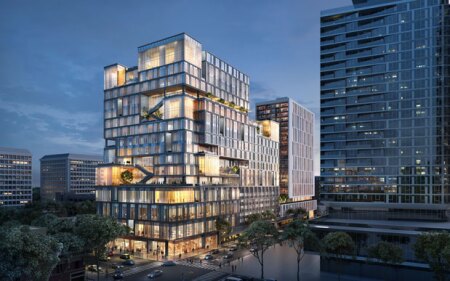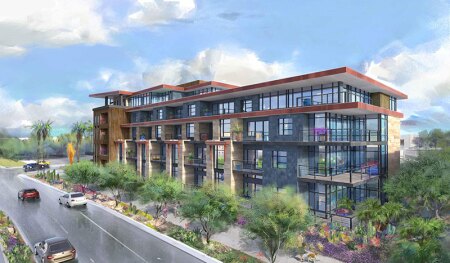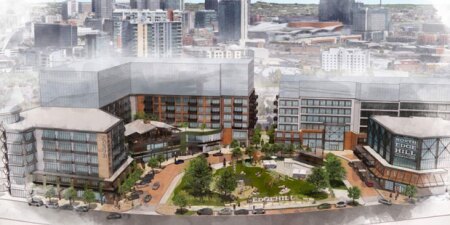Out of the wreckage of the COVID-19 pandemic, Qualified Opportunity Zone (OZ) funds accelerated last year, with nearly $7 billion in new capital raised during the second half of 2021. Much of that money appears to be directed into multifamily housing projects erected from the ground up in high-growth markets in California, Arizona, and the Pacific Northwest, in addition to Georgia and other Sun Belt states.
Jeff Feinstein and Leo Backer founded Seattle-based Pinnacle Partners in 2018, not long after the OZ program was formalized within the U.S. Tax Cuts and Jobs Act that was the centerpiece of the 2017 tax overhaul. They launched into a flurry of seven separate single-asset funds from the outset, raising between $15 million and $25 million for each from high-net-worth investors. Pinnacle’s current fundraising effort will be the largest yet--$100 million in Fund 8 to finance four sizable projects in such cities as Atlanta, Denver, and Nashville.
“From the start four or five years ago other real estate firms saw opportunity zones as just another investment vehicle, another reason to raise capital,” says Feinstein, Pinnacle’s managing partner. “We were different from the start. We saw these opportunity zones as compelling investments. We decided to work only with developers doing deals in these zones.”
Pinnacle’s money is undergirding such apartment projects as Canton Lofts in Seattle; Brooklyn Basin in Oakland, California; and the Lair in Berkeley. Backer, Pinnacle’s other managing partner, had been an office rep for many years, but when he and his partner were presented with the historic Astor office tower in downtown Tacoma, Wash., they decided to flip it to 156 apartment units spanning 18 floors.
It’s no accident that multi-family has emerged as the go-to investment in OZ tracts, says Backer. Opportunity zones were conceived as a means for wealthy investors of all kinds to cash in capital gains—from other real estate or ordinary stocks or the sale of businesses—and defer taxes until the official end of the OZ program in 2026. Meanwhile, all profits from that reinvested money are shielded from taxes if the investment is held a full 10 years or longer. The money must also be invested within the 8,764 OZ tracts designated by state governments—pegged to below-average income demographics identified by the 2010 census. Opportunity zones have certain advantages over the century-old 1031-exchange program in that any kind of profits, not just those from real estate, are eligible to be reinvested. And 1031 merely postpones a tax reckoning unless the investor holds onto property until death, when heirs are allowed to step up the value.
The problem with offices in OZ investing, Backer explains, is that too often they don’t lend themselves to long-term holds. “Offices reach their peak value the moment you lease them up. They actually lose value as you get closer to tenants’ lease expirations five or 10 years later,” he notes.
Retail real estate investing is virtually out of fashion these days as internet merchandising has taken hold. Industrial warehouses, fed by the demand from Amazon, is a hot commodity now, but also doesn’t lend itself to OZ, says Backer. “Developers don’t need much capital for industrial,” he says. “They can put these buildings up with regular construction loans and lease them up with little effort and then sell them at peak value. There is rarely any reason for a 10-year hold.”
For many fund sponsors, that leaves multifamily as the fallback asset class. Chicago-based Jackson Dearborn Partners was founded in 2014 and did some 1031-exchange funded projects before switching to its first OZ project in June 2019. Since then it’s launched the 126-unit Chandler One apartments in suburban Phoenix, the 374-unit Solace at the Ranch in Colorado Springs, and the 355-unit Converge at Ballpark Village in Goodyear, Arizona. The firm has delivered a half-dozen projects so far and is working on lots more, according to Ryan Tobias, managing partner.
The multifamily focus is not surprising, Tobias says, since apartments are rising everywhere anyway. Beyond that, he adds that it suits a 10-year hold because “multi-family is populated by folks with one-year leases. It doesn’t have a key fixed end like office or retail or other classes that depend on longer term leases that dictate the timeliness of the investment.”
There is a trade-off, of course. Long-term holds typically sacrifice some profit. “A merchant developer flipping a project in three years is going to get a better return than the guy who is holding for 10 years,” Tobias says. How much difference is there? Tobias figures that the conventional project projected to earn a 20 percent or better internal rate of return is going to lose two or three percentage points in return. Others put the difference in return even higher. Yet investors will typically swallow that difference because their eventual tax benefits will more than make up for it.
Unexpected Outcomes
There was some expectation at the outset that OZ investing might be directed at impoverished and beaten-down inner-city tracts in desperate need of redevelopment. It hasn’t worked out that way. In Chicago, the Habitat Co. has been dedicated to affordable housing for decades and was a key player in the redevelopment of the city’s public housing. Habitat is a partner in a $200 million mixed-use project called Ogden Commons that will include 350 mixed-income housing units in the North Lawndale neighborhood. Ogden is in an OZ, and the hope had been that OZ funding would be a key component in the capital raise. But as it turned out institutions, including PNC Bank, have stepped in and underwritten the project largely with Low Income Housing Tax Credits instead.
Jeff Head, vice president for development with Habitat, had once harbored some hope that OZ and LIHTC investing could occur side-by-side in urban projects. “These tax-credit developments are viable long-term assets for banks with tax credit investing platforms. But the real estate doesn’t appreciate a lot and doesn’t bring high returns,” Head says. “One thing we have found is that OZ investors do care about yield. Banks have lower yield expectations, by comparison.”
None of this has come as a surprise to Erik Hayden, founder and managing partner at Urban Catalyst, headquartered in San Jose, California. His first fund raised $131 million to finance six projects, all in San Jose. The investments have been a mix encompassing offices, retail, student housing, a Marriott, a senior living facility and apartments. The firm’s second fund will get even bigger—$200 million, with half that raised so far. Like other developers and fund managers, Hayden emphasizes that his investors have fixed a high priority on OZ yields. “They hear about us at first because we are in OZs with tax benefits, but they invest in us because of the project’s ability to bring a return. We look at OZ tax benefits as just the icing on the cake. What really matters is the nuts and bolts of your project,” Hayden says.
Many observers have suggested that OZ investing ought to be geographically diversified to afford investors protection. But Hayden, who depends on debt for roughly 65 percent of his deals, singularly rejects that notion. He has lived in the heart of the Silicon Valley for years and knows local lenders and city officials and contractors intimately, something he can’t count on in other places. Moreover, his investors—$250,000 is the minimum buy-in he accepts—seem to like his approach.
Even if they do, Hayden admits that OZ fundraising can be tedious. He spends long days putting out calls to qualified high net-worth individuals. “A big group like Blackstone can make one call to a pension fund and raise $5 billion. I’ve got to make lots of calls to raise just $200 million. Many developers don’t get into opportunity zone investments because they figure they aren’t worth the trouble,” Hayden says.
Still, they are getting created. Novogradac, an accounting firm in San Francisco that tracks the industry, reports that in the last six months of 2021 $6.88 billion was poured into OZ funds. The firm, which tracks more than 1,300 funds around the nation, estimates that $24.4 billion has been raised overall in the past five years. California ranks as the top OZ state (by dollars raised), followed in order by Arizona, Texas, New York and Florida. The top ranked OZ cities included Washington, D.C., Los Angeles, Nashville and Austin, Texas, according to Novogradac.
These numbers, however, may capture only a portion of the big picture. John Sciarretti, a Novogradac partner, concedes that his firm only counts investments by funds with multiple investors. Other studies have shown that adding single-investor funds to the mix would swell the OZ total to $75 billion or more. “There was a lot of money invested at the end of last year, and I haven’t seen that slow down this year so far,” Sciarretti says, estimating broadly that the OZ market this year could grow by another 30 percent. There is a reason for the rush to shelter capital gains, he points out: the stock market hit all-time highs last year and there was record activity in mergers and acquisitions so wealthy individuals were cashing out all over. “There were lots of gains and people didn’t have a lot of options to reinvest,” Sciarretti says.
Future of the Program
Sciarretti and others are betting that Congress, noting the pandemic interruption for many families, will eventually vote to extend OZ by two years, or perhaps even make it permanent. If that happens, there is no limit to how big OZ could become, they say. Nick Gibbons, a CPA in the accounting firm Armanino in San Jose, calculates that the economics for investors are compelling. For investors who hold an OZ investment for a full 10 years and realize their profits tax-free, there is at least a 23 percent tax-aided bump in returns. “You still have to look closely at your investment and try to be sure the real estate is going to appreciate over 10 years. If it doesn’t, then the tax benefits are meaningless,” Gibbons explains. “But for the average piece of real estate, the OZ benefit is huge.”
To catch the attention of investors, many funds are filling unusual niches they can call their own. USG Realty Capital raised $40 million in its first fund in 2019 and has kept raising since. Now it’s focused on infill sites where land is in short supply. That means a new multi-family project is unlikely to face competition. “We look for infill deals that will be holding their value in the eight or tenth year,” says Greg Genovese, the founder and CEO of USG. “If we go into a boom or bust market like Phoenix our apartment building may be facing another new building 300 feet away in a few years.”
Next to the Las Vegas Harry Reid International Airport on the south end of the Strip, where Integris Real Estate Investments is putting up its 526-room Dream Las Vegas Hotel and Casino on a 5.25-acre (2.12 hectare) site, CEO William Shopoff likes his long-range prospects. “As it is we are bumping up against the airport,” he says. “The airport has been buying up vacant land [as buffer] and so it looks like nobody else will be able to do development around us in the future.”
His project isn’t the classic multi-family, but Shopoff thinks that government officials overseeing his project might come to value it as a model for OZ building in the future. One of the original goals of OZ legislation, he recalls, was to be a job creator. With a hotel and casino, Dream Las Vegas will create 4,000 short-term construction jobs and another 800 permanent jobs to man the hotel and casino. Once built, by contrast, apartments require little labor going forward.
At Origin Investments in Chicago, Michael Episcope, the co-CEO, admits that deal flow can be a challenge for the OZ funds he manages. By law, OZ money sheltered from capital gains taxes must be invested in a designated project within six months of receipt. In an older fund, Episcope actually shut down fundraising for six months to allow his acquisition team the time to find suitable deals. The latest fund, open since September, is well past the $100 million mark already. “Our pipeline now is prolific and the investment has more velocity,” Episcope observes. His strategy? He likes to “fish” around the edges of opportunity zones, with projects in Phoenix and Atlanta located practically across the street from market-rate development. He also likes multi-family “because it has less volatility and good diversity. By comparison, if you’re invested in an office and a tenant blows out in 10 years you’ve got a big headache.”
At Caliber Wealth Development, Conor Donohue, vice-president of wealth development, says that his firm’s OZ investing will increasingly move beyond its Arizona base (it’s headquartered in Scottsdale). He is studying population movement, predicting that his future projects are likely to come in Texas and Colorado and Utah and even Idaho. “Boise is one of the fastest growing cities in the country. People are moving there from the Seattle and Portland areas,” he notes.
And yet critics wonder whether such places already experiencing high rates of growth need tax-sheltered investment to fuel even more expansion. Some Democrats in Congress have called for a realignment of select older OZ tracts that have gentrified to higher income populations. “It may be that some of the opportunity zones shouldn’t have been designated OZ in the first place,” says Jimmy Atkinson, founder of OpportunityDb.com, a platform for OZ sponsors and investors based in Fort Worth, Texas. “The process hasn’t been perfect. But recently the marketplace has solidified and become much more serious. For the most part, OZ funds are accomplishing what they were designed to do.”









